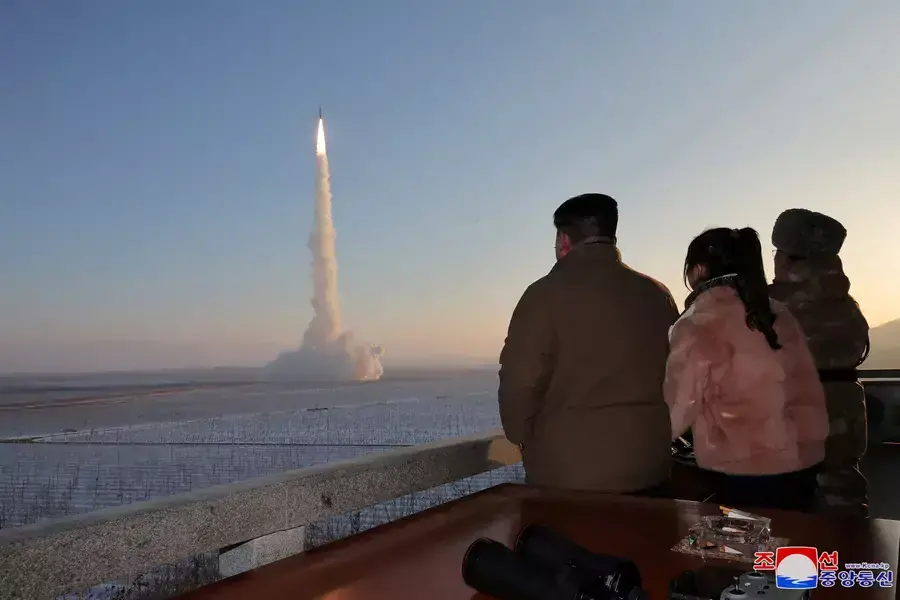Satellites, Summits, and Succession in North Korea

Though North Korea had yet to fully resume its pre-pandemic activities by the end of the year, Supreme Leader Kim Jong-un celebrated major successes in safeguarding and strengthening North Korea and the Kim family dynasty in 2023. In so doing, Kim appears to have set a course to generate more tensions in 2024.
There was an apparent successful launch of a North Korean satellite in November 2023 following two failed attempts. International summits and accompanying military exchanges with Russia resumed. 2023 saw the public emergence of Kim’s daughter, Kim Ju-ae, who alongside his sister, Kim Yo-jong, are the leading representatives of the Kim family dynasty.
More on:
These accomplishments are intended to address North Korea’s vulnerabilities while enhancing the resilience, legitimacy, and longevity of North Korea under Kim Jong-un.
North Korea claimed to have successfully launched a satellite into orbit on 21 November 2023. Within hours of the launch, North Korea’s state media claimed it had obtained reconnaissance images of the White House, Pentagon, and various U.S. naval facilities — but there is no independent confirmation of the imagery.
North Korea defended its right to pursue satellite launches and pledged to launch more despite UN Security Council resolutions prohibiting North Korea from developing technology applicable to ballistic missiles. North Korea’s successful satellite launch has fueled a space race with South Korea, which is pursuing its own reconnaissance satellite network. North Korea’s satellite launch may augment South Korea’s already extensive human and cyber intelligence efforts to ensure its security.
In addition to satellites, North Korea tested around 40 ballistic missiles, including solid-fuel Hwasong-18 intercontinental ballistic missiles (ICBM). Though North Korea tested a record five ICBMs in 2023, the pace of overall missile testing was only about half that of 2022. This slowed testing came despite the gradual deterioration of inter-Korean relations and North Korean complaints regarding U.S. foreign policy, U.S.-South Korean military exercises and UN criticism of North Korea for pursuing missile tests and satellite launches. Missile testing has continued despite North Korea facing serious and unresolved economic hardship as the country emerges from self-imposed isolation during the COVID-19 pandemic.
North Korea’s successful satellite launch precipitated the escalation of inter-Korean tensions around the demilitarized zone, resulting in both countries suspending their adherence to the 2018 Comprehensive Military Agreement. North Korean plans for military development in 2024 will likely include further efforts to develop a nuclear attack submarine, while South Korean legislative elections in April and U.S. presidential elections in November may feed an escalation of tensions with North Korea.
More on:
There has been a convergence of North Korean and Russian interests. Russia has an acute need for munitions and North Korea is a willing supplier. This convergence has revived a geostrategic alignment between the two countries to levels not seen since the 1960s. The shift toward major power rivalry as the main driver of international politics and Russia’s need for munitions to continue its war on Ukraine have made North Korea a relevant partner for the first time in decades.
For Kim Jong-un, the September 2023 summit with Russian President Vladimir Putin marked a foreign policy reset under new conditions of geopolitical rivalry in which North Korea’s quest for international legitimation as a nuclear state no longer requires affirmation from the United States. The summit with Putin was sufficient to forward Kim’s desires for international legitimation and secure protection from additional UN Security Council punishments for long-range missile testing and satellite launches.
The North Korea-Russia strategic relationship marks Kim’s post-pandemic international alignment with China and Russia in the face of a shared enemy — the United States. The duration of Russia’s need for munitions and the level of support North Korea will gain through boosting its military development remain to be seen.
North Korea’s opportunity to overcome its decades-long inability to import state-of-the-art military armaments marks a significant shift in its foreign policy. North Korea is transitioning from a focus on the inter-Korean balance on the Korean Peninsula to one increasingly influenced by the dynamics of the opposing North Korea-China-Russia and United States-South Korea-Japan coalitions in the region.
Kim has made strides on the issue of succession, in the form of a more visible and front-facing image of his daughter, Kim Ju-ae, and the proclamations of his sister, Kim Yo-jong. The public profile of these two family members under Kim Jong-un’s leadership speaks to the importance of familial support and plans for a possible fourth-generation dynastic succession.
Following Kim Ju-ae’s first public appearance in November 2022, the importance of her role in the pictorial narrative of North Korean leadership has become more apparent. The North Korean media’s tone toward Kim Ju-ae has become more reverential, indicating her status as one of the most honored North Koreans. This led South Korea’s National Intelligence Service to conclude that Kim Ju-ae has been designated as Kim Jong-un’s most likely successor.
Kim Yo-jong has played a less visible but more voluble role than Kim Ju-ae. This signals that she could play a critical transitional role in a succession process where Kim Ju-ae is not immediately capable of assuming leadership.
There remains skepticism as to whether Kim Ju-ae would be a viable leader in the patriarchal North Korea. One can only imagine what behind-the-scenes maneuvering might be required to support the succession process. Still, it is clear that Kim Jong-un has taken active steps to address one of the most obvious future vulnerabilities that the Kim family regime might face.
The article was originally published on the East Asia Forum.
 Online Store
Online Store